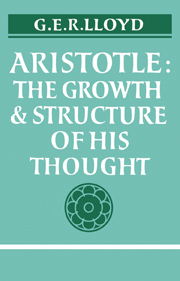Book contents
- Frontmatter
- Contents
- Preface
- Abbreviations
- PART I INTELLECTUAL DEVELOPMENT
- PART II FUNDAMENTALS OF ARISTOTLE'S THOUGHT
- 6 Logic and metaphysics
- 7 The physics of the heavenly region
- 8 The physics of the sublunary region
- 9 Psychology
- 10 Ethics
- 11 Politics
- 12 Literary criticism
- 13 Conclusion
- Suggestions for farther reading
- Glossary of Greek terms
- Index of passages referred to
- General Index
13 - Conclusion
Published online by Cambridge University Press: 06 July 2010
- Frontmatter
- Contents
- Preface
- Abbreviations
- PART I INTELLECTUAL DEVELOPMENT
- PART II FUNDAMENTALS OF ARISTOTLE'S THOUGHT
- 6 Logic and metaphysics
- 7 The physics of the heavenly region
- 8 The physics of the sublunary region
- 9 Psychology
- 10 Ethics
- 11 Politics
- 12 Literary criticism
- 13 Conclusion
- Suggestions for farther reading
- Glossary of Greek terms
- Index of passages referred to
- General Index
Summary
Discussing the growth of Aristotle's thought, I argued that there is an important continuity in his development Naturally his views on many questions, including, for example, such a fundamental problem as the ultimate source of movement in the universe, changed during the course of his life, and he certainly also developed important, and engrossing, new interests. But whether any drastic revolution took place in his thought is doubtful.
Even his rejection of the teaching of Plato was not a matter of a simple, sudden and dramatic break so much as a complex, gradual and continuing process. His disagreements with his master date from early in his career and for some time after he had rejected the theory of Forms he still considered himself a member of the circle of Platonists. Conversely, long after his links with the Academy had become rather tenuous, there remained much in common between his mature philosophy and Plato's. Moreover while in zoology, for example, he pioneered a new approach to the study of the animal kingdom, his detailed investigations in that field tended to endorse certain doctrines, such as that of the final cause, that owe an obvious debt to Plato. Aristotle's work was wider-ranging and more original than that of any earlier philosopher, indeed of any philosopher of any time, but certain methodological assumptions and key ideas underlie a great deal of his thought.
- Type
- Chapter
- Information
- AristotleThe Growth and Structure of his Thought, pp. 283 - 315Publisher: Cambridge University PressPrint publication year: 1968



